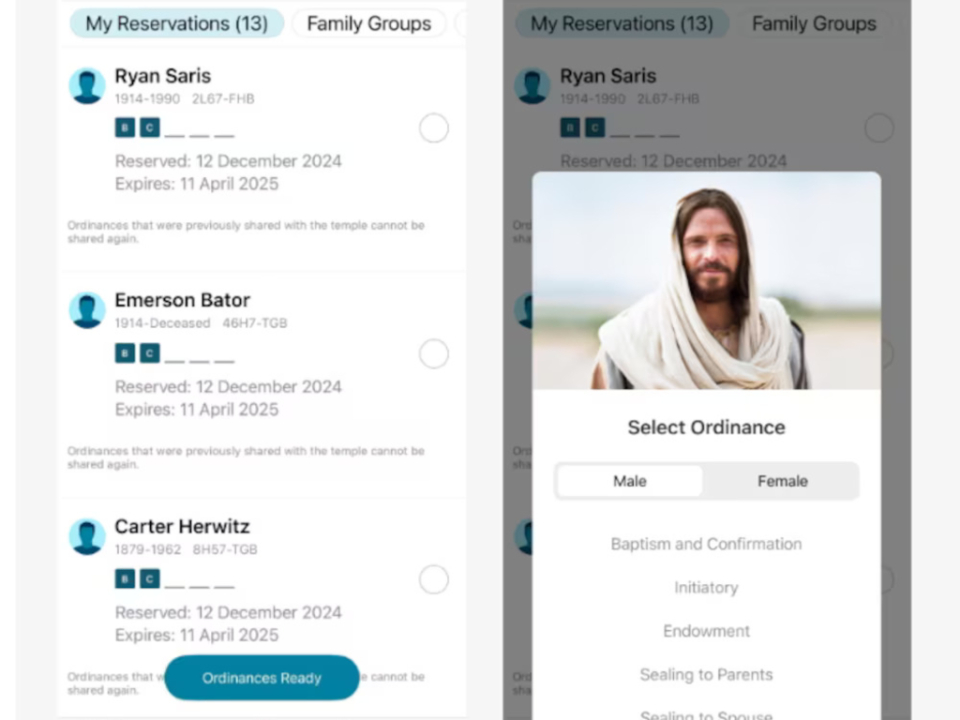
ordinance-ready-1
Members of the Weir family take a photo outside the Layton Utah Temple on Sunday, June 16, 2024, courtesy of Church News.All rights reserved.This story appears here courtesy of TheChurchNews.com. It is not for use by other media.
By Trent Toone, Church News
In his six-plus years as President of The Church of Jesus Christ of Latter-day Saints, President Russell M. Nelson has continually emphasized the importance and blessings of temple worship.
“It is significant that the Savior chose to appear to the people at the temple. It is His house. It is filled with His power,” he said in October 2022 general conference. “Let us never lose sight of what the Lord is doing for us now. He is making His temples more accessible. He is accelerating the pace at which we are building temples. He is increasing our ability to help gather Israel. He is also making it easier for each of us to become spiritually refined. I promise that increased time in the temple will bless your life in ways nothing else can” (“Focus on the Temple”).
The process of finding a family name to take to the house of the Lord has never been easier.
With the click of a button, a tool on the FamilySearch Family Tree app called Ordinances Ready searches a member’s family tree to find an ancestor for whom ordinance work can be performed. The member then selects an ordinance and brings the name to the temple. If a relative is not found, Ordinances Ready can provide a name from a member’s ward or stake.
The simplicity of Ordinances Ready is “striking,” but many people may not have used it before and therefore do not know how simple it is, Elder David A. Bednar of the Quorum of the Twelve Apostles said in the 2023 Temple and Family History Leadership Instruction.
“Many people have expectations that this is more labor-intensive and time-consuming than it actually is,” he said. “In this season of the dispensation, to have this kind of miraculous tool to accomplish this work is a tremendous blessing.”

ordinance-ready-2
A hand is pictured using a mobile device to use the Ordinances Ready tool on the FamilySearch Family Tree app, courtesy of Church News.All rights reserved.The goal of Ordinances Ready is to simplify the process of finding, submitting and performing ordinances for kindred dead, said Elder Kevin S. Hamilton, a General Authority Seventy and executive director of the Church’s Family History Department.
“We are trying to make it as simple as possible so that anyone can do it, including those that perhaps are not very experienced with family history,” he said.
Elder Hamilton and Elder Jorge M. Alvarado, a General Authority Seventy and assistant executive director of the Family History Department, discussed Ordinances Ready in a Church News interview.
Launched in 2018
Elder Hamilton said the question that inspired engineers to develop Ordinances Ready was always, “How do we make this easier?”
“Family history and genealogy, by nature, can be complicated. It requires a lot of knowledge and experience. For 95% of us it is a roadblock because we do not know quite what to do,” he said. “What we really want to do is just take a family name to the temple and perform ordinances.”
A team of FamilySearch engineers and computer scientists tackled the challenge by studying how people interact with technology and the process for submitting a temple name. They eventually developed an automated approach that became Ordinances Ready, which was launched in 2018.

ordinance-ready-3
Elder Kevin S. Hamilton, General Authority Seventy, and his wife, Claudia, greet students following a BYU–Idaho devotional in Rexburg, Idaho, on March 12, 2019. Photo courtesy of Church News.All rights reserved.Perhaps the biggest hurdle with Ordinances Ready has been awareness. Not enough people are yet fully aware of it and have taken the opportunity to try it, the Church leaders said.
“Once they do, they never go back,” Elder Hamilton said. “It is a wonderful experience, very personalized, very much about family, and helps me realize I am a Savior on Mount Zion for my family. They are depending on me. These are real people.”
How Ordinances Ready Works
Members can use Ordinances Ready to find a family name in a matter of minutes. It is not complicated.
“I have seen 11-year-olds and 93-year-olds use this, and you do not have to know much about technology,” Elder Hamilton said. “You do need to have a FamilySearch account and know how to open that account and look at your family tree. But literally, with a few keystrokes, every person can have a name. Most of the time it will be family related ... and that will enhance, improve and bless your temple worship experience in a remarkable way.”
Here are steps for using the FamilySearch Family Tree app:
-
Open the FamilySearch Family Tree app.
-
Click Temple and then Ordinances Ready.
-
Select ordinance type. When informed, “We found people needing ordinances,” press View People.
-
Make selection and press Continue. Print cards at home, at the temple or click Save to Photos. The option to Schedule Temple Appointment is then offered.
-
Learn more about the family member by clicking the person’s name and View Person. See how you are related to him or her by clicking on View Relationship.

ordinance-ready-4
Screenshots show the steps for how to use Ordinances Ready tool on the FamilySearch Family Tree app. Screenshot from FamilySearch Family Tree app, courtesy of Church news.All rights reserved.
ordinance-ready-5
Screenshots show the steps for how to use Ordinances Ready tool on the FamilySearch Family Tree app. Screenshot from FamilySearch Family Tree app, courtesy of Church News.All rights reserved.Steps for using the FamilySearch website:
-
Sign into your free FamilySearch.org account.
-
At the top of the page, click Temple and then Ordinances Ready on the drop-down menu.
-
Select an ordinance type and click Take to the Temple in the lower-right corner.
-
A box will appear with instructions on how to print the family name card. Members can print out a family name card at home or have the temple office scan a QR code to print the cards. Another option is to write down the 16-digit family ordinance number and take it to the temple.
-
Learn more about the family member by clicking the person’s name and View Person. See how you are related to him or her by clicking on View Relationship.
Elder Alvarado remembers showing family members the process and how excited they became when they realized how simple it was to “touch a button” and “select an ordinance.” After reserving an ordinance, one of his favorite things to do is view his relationship with the ancestor and learn more about them.
“It makes it very personal,” he said. “It’s so simple that by pressing a button and you have someone there that is related to you.”
FamilySearch has added a few features to Ordinances Ready in recent years.
-
Filtering features allow members to filter names by ordinance, gender and date.
-
Members can share names with individuals, family groups, wards and stakes. Any kind of group can be organized, such as immediate family, extended family, elders quorum, Relief Society or friends at work.
FamilySearch will continue to consider ways to improve the Ordinances Ready tool.
“We think we found the answer ... but something along the line will come our way that will help us be more effective and efficient in what we do,” Elder Alvarado said.
‘On the Steps of the Temple’
Ordinances Ready is so quick and convenient, Elder Hamilton and Elder Alvarado have both used the tool to get a family name while walking from their vehicle to the doors of the temple.
“As I’m walking into the temple, I pull out my smartphone, tap Ordinances Ready, get the QR code and show the kind [workers], who print the name card for me,” Elder Hamilton said. “I have done that many, many times.”

ordinance-ready-6
Young men walk outside a temple of The Church of Jesus Christ of Latter-day Saints.2024 by Intellectual Reserve, Inc. All rights reserved.Added Elder Alvarado, “I just don’t use paper anymore. I go to the temple and print it out.”
The process could become even easier. Elder Hamilton said the Church is testing the use of a family name kiosk that sits in the entry of half a dozen temples along Utah’s Wasatch Front. Before a member reaches the recommend desk, he or she can scan the QR code and the kiosk prints out the name card, similar to printing out a boarding pass at the airport.
“As we get that perfected, we anticipate that will spread to other temples,” Elder Hamilton said.
Available Worldwide
Ordinances Ready is not just in North America but is available worldwide in more than 40 languages.
A short time ago, on the steps of a temple in Peru, Elder Alvarado explained the simplicity of Ordinances Ready to a group of 15 Latter-day Saint young adults. They were amazed to learn they didn’t need to wait for the temple to give them a name; they could do it themselves. When Elder Alvarado spoke with their bishop three months later, the bishop reported that temple attendance had increased and every youth was using a phone to get a family name.

ordinance-ready-7
Elder Jorge M. Alvarado and his wife, Cari Lu, talk to the crowd gathered at a devotional during the RootsTech After-Party for young single adults at the Salt Palace Convention Center in Salt Lake City on Friday, March 1, 2024. Photo by Brian Nicholson, for Deseret News, courtesy of Church News.2024 by Intellectual Reserve, Inc. All rights reserved.Elder Alvarado also remembers a member using Ordinances Ready in Haiti to get a French family name in 2019.
“Everybody can participate and feel ‘I am part of this,’” he said. “It’s about doing the Lord’s work of salvation and exaltation and bringing those ordinances to His children.”
‘A Different Experience’
The two Church leaders agreed that performing a temple ordinance by proxy for a family-related name has added power.
“Every time we go to the temple — whether we know the person we are standing as proxy for or not — is special. But when it’s a family name, I think, ‘This is my family.’ I may not know them, but someday I will, and I will feel the same about them as I do my mother or grandfather,” Elder Hamilton said. “When I stand as a proxy in the temple for family members, it is just a different experience.”
Elder Alvarado has also felt a strong “connection” with his deceased ancestors while performing temple ordinances on their behalf.
“Don’t worry if you have not done your genealogy. The work is being done around the world,” he said. “There is a family name out there that is waiting for you. ... You can go and bring those ordinances and save more of Heavenly Father’s children. ... This is the era of coming to the house of the Lord to help someone while helping yourself.”
As 11- and 12-year-olds transition from Primary to Young Men and Young Women in 2025, the two Church leaders encouraged parents and leaders to help them create their first FamilySearch account and use Ordinances Ready to take a family-related name to the house of the Lord.
“That will enhance the experience for these brand-new temple worshipers,” Elder Hamilton said. “The beauty of Ordinances Ready is they can do this. They can get a FamilySearch account and take four or five names to the baptistry. It will change their experience.”

ordinance-ready-8
Young women sit outside a Latter-day Saint temple.2024 by Intellectual Reserve, Inc. All rights reserved.Copyright 2024 Deseret News Publishing Company.